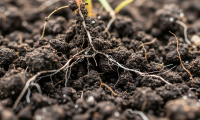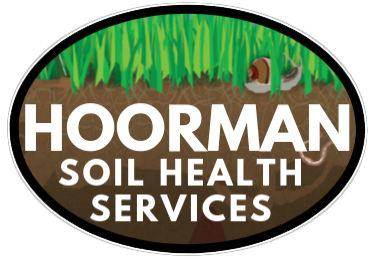Phosphite: A Natural Fungicide

Farmers struggle with two major types of fungal pathogens. First are the soil pathogens which thrive on newly planted crops, especially in cold wet soils planted early in the growing season. Second are the foliar leaf pathogens that generally affect plants later in the growing season. The following discussion is on the use of phosphite as a natural soil fungicide and bio-stimulant for early season soil fungal control and fast plant growth.
Innovations in Agriculture

On December 3rd, several Ohio speakers discussed weather, Artificial Intelligence (AI) in agriculture, and precision soil sampling at the Ohio No-Till conference, Der Dutchman, Plain City Ohio. Here are their comments.
Role of Secondary and Micronutrients

Farmers try to balance the big three nutrients for plant growth: nitrogen (N) phosphorus (P) and potassium (K) since they are known to increase crop yields. However, for good soil health and good plant health; the secondary nutrients: calcium (Ca) Sulfur (S) Magnesium (Mg) and micronutrients are also important.

Digging Deep into Nutrient Content & Function
James J. Hoorman
Hoorman Soil Health Services
Hoorman Soil Health Services
Understanding Biologicals
James J. Hoorman
Hoorman Soil Health Services
Hoorman Soil Health Services
OUR STORY
Jim and Marlene Hoorman reside in Hancock County, Ohio south of Findlay at Jenera, Ohio on a 40-acre farm. Our son Jonathan is now 25 years old. He graduated from Ohio State University in 2022 with a degree in Agricultural Economics. He worked as a grain buyer for Archer Daniel Midland facility in Toledo and now works for United Equity as an agronomist. He recently got married on April 5, 2025 to Maggie Miller Hoorman and now they reside in Anna Ohio. She works as a lab technician for Cumberland Valley Analytical Services at Fort Loramie, Ohio. Jim has been working in agriculture and farming since he was 13 years old, first picking strawberries then working for Kleman Brother’s Farm as a hired hand. Corn, Soybeans, Wheat, Hay, Tomatoes, Sugar Beets, Cucumbers and Sweet corn were major commodities along with hogs and cattle. Jim attended Ottawa-Glandorf High School and was an honor student and active in 4-H and Boy Scouts. Jim was also diagnosed as a diabetic and has lived with this condition for over 44 years, taking insulin shots and then being on the insulin pump for over 12 years.
Jim and Marlene Hoorman reside in Hancock County, Ohio south of Findlay at Jenera, Ohio on a 40-acre farm. Our son Jonathan is now 25 years old. He graduated from Ohio State University in 2022 with a degree in Agricultural Economics. He worked as a grain buyer for Archer Daniel Midland facility in Toledo and now works for United Equity as an agronomist. He recently got married on April 5, 2025 to Maggie Miller Hoorman and now they reside in Anna Ohio. She works as a lab technician for Cumberland Valley Analytical Services at Fort Loramie, Ohio. Jim has been working in agriculture and farming since he was 13 years old, first picking strawberries then working for Kleman Brother’s Farm as a hired hand. Corn, Soybeans, Wheat, Hay, Tomatoes, Sugar Beets, Cucumbers and Sweet corn were major commodities along with hogs and cattle. Jim attended Ottawa-Glandorf High School and was an honor student and active in 4-H and Boy Scouts. Jim was also diagnosed as a diabetic and has lived with this condition for over 44 years, taking insulin shots and then being on the insulin pump for over 12 years.
Using Cover Crops as an IPM Tool for Managing Hard-to-Control Weeds
While herbicides provided an opportunity to expand many important soil conservation practices, overuse of glyphosate and the evolution of glyphosateresistant weeds poses one the greatest threats to conservation tillage as it has forced some farmers to revert to conventional tillage for effective weed control.
Weeds in Cover Crops: Context and Management Considerations
Cover crops are increasingly being adopted to provide multiple ecosystem services such as improving soil health, managing nutrients, and decreasing soil erosion. It is not uncommon for weeds to emerge in and become a part of a cover crop plant community.
Soil Nutrients
Fact Sheet
Fact Sheet
The availability of soil nutrients is dependent on three factors. One is the chemical form that it can be taken up by the plant. Two is the proximity to actively absorbing plant root. Three is the soil nutrient in a soluble form that can be absorbed by plant roots. Most plant roots require moist soil and water to absorb soluble nutrients.
Best of ‘22: No-Tilling in Wildly Different Regions, Encouraging Better Root Growth & More
Jim Hoorman, with Hoorman Soil Health Services discusses how micro-nutrients may be one of the best ways to improve no-till crop yields. Over the past 160 years, many farms have been tilled and due to soil erosion; lost soil, soil organic matter, and the attached micro-nutrients. Micro-nutrients are needed in small amounts to activate enzymes that increase not only soil health, but also improve plant growth and increase plant yield. Jim discusses micro-nutrient functions and importance, how to identify micro-nutrient deficiencies, and how to apply micro-nutrients to reduce nutrient deficiencies.
HUMIC, FULVIC and MICROBIAL BALANCE:
Organic Soil Conditioning
Organic Soil Conditioning

From the Amish of Ohio to the crops of California, through the documented research from universities around the world, explore nature's natural balance.




